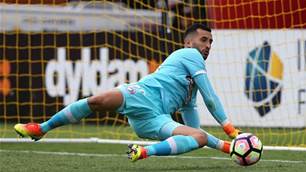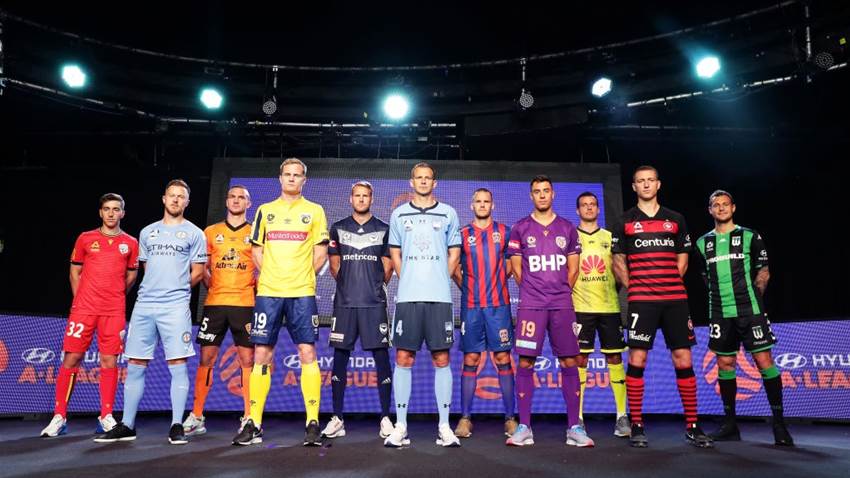Broadcasting rights for the A-League have been won by Channel 10, its US owner ViacomCBS, and its new streaming service Paramount+.
Network 10 has confirmed the deal, which is reportedly worth $200 million over five years, with an option to trigger a three-year extension.
The deal is being led by Network 10's new owner, ViacomCBS, which is launching a new digital streaming service called Paramount+ in Australia this August.
The new A-League and W-League seasons, which are tentatively scheduled to begin in October, will be broadcast live in their entirety on Paramount+, which will cost Aussie subscribers $9 per month and feature a large amount of other US content.
In addition, a live A-League match will be broadcast every Saturday night on free-to-air television on Channel 10 and a live W-League match will be shown every Sunday on Channel 10's free-to-air subsidiary network, 10Bold.
The deal, according to The Sydney Morning Herald, is worth $32 million in cash for the first year, which is still far below Fox Sports' original A-League deal before the COVID-19 pandemic.
However, it involves a further $11 million in a contra account, which is a little like an expense account that then reduces over the term of the deal.
W-LEAGUE, A-LEAGUE TV DEAL DOWNSIDES
If the deal has obvious downsides this early on, it's firstly, that the W-League is now relegated from ABC's main channel to 10Bold, which only accounts for around 2% of overall free to air (FTA) television ratings.
Secondly, it's that Channel 10 is in a period of transition at the moment, which means it's entering the digital streaming market very late, with quite low free-to-air television ratings to sell its new product through.
Furthermore, ViacomCBS is reportedly planning on taking some of Channel 10's best rating programs and moving them to their subscription Paramount+ service, which would be troubling for an already struggling station.
Channel 10's share of Australian FTA ratings has declined from 16% in 2010 to 9% in 2019. Including its digital stations, it's fallen from 17.3% to 14%.
That's less than the ABC, which the A-League and W-League have just left, so the APL director Danny Townsend's remarks that the deal represents "unprecedented reach" may be a little overblown.
On Saturday nights at 7:30pm, when the A-League will show live, Channel 10 commands around 7% of the national ratings.
This will likely decline further when the A-League has to compete dead on with Saturday night AFL or rugby league towards the backend of the season.
10 News First, on a Saturday, gets around 75% lower ratings than the news on Channel 9, Channel 7 and ABC, all of which get around the 750,000 - 800,000 viewership mark. 10 News will then lead more or less directly into Channel 10's new A-League panel show, set to kick off in October.
PARAMOUNT+ EFFECT
However, the station's current overhaul comes with the prospect of growth, which is exactly how Channel 10 is selling itself at the moment.
Channel 10 is the only Australian network that has actually grown its viewership over the past 12 months, up 6% in the under-50s market.
10Bold has actually been the major driver of much of this increase, raising its viewership by a whopping 19% among over 40s, which surprisingly, is one of the W-League's biggest markets.
The A-League is also arguably going to be of more importance now to Channel 10 and Paramount+ than it's ever been to a broadcaster before.
Previous FTA partners have generally had other sports they were more interested in broadcasting, or have simply been buying Fox Sports packaged coverage, often with time delays or other disadvantages.
Fox Sports and Kayo themselves also had far more lucrative sports deals, that generally drew much higher ratings.
Channel 10 have also lost the broadcasting rights to cricket's Big Bash League, which leaves football as its only mainstream sport. The only other sports 10 has of real note at the moment are motorsports, yet it's previously been very keen on marketing itself as a sports-centric network.
Meanwhile, Paramount+ has very little Australian content and no other Australian sports. But it's setting its bar very high.
It enters the market at a very low relative cost, with quite a lot of US programming, and it has the rights to show the UEFA Champions League in the USA, so may yet win the rights to show this competition in Australia given the last bidders, Sports Flick, now look like a flash in the pan.
SOCCEROOS, MATILDAS TV RIGHTS
The real interest to Australian football fans is whether Paramount+ now bid for Socceroos and Matildas matches, which are being sold separately by the FA. Some sources indicate that Amazon Prime is currently leading the race for national team rights.
But in one of the more interesting parts of this deal, ViacomCBS is putting some skin in the game by taking a 2.5% ownership stake in the APL (A-League and W-League clubs).
This may assist in the APL's current plan, which it's pursuing simultaneously to this deal, to attract $150 million in equity from an investment firm, which would allow the APL to produce its own broadcast package of A-League and W-League games, which it can then sell around the world, including to Paramount+.
As part of this transition, the APL will start producing Paramount+ gameday content, from commentary and camera vision of matchdays all the way to a free-to-air A-League panel show.
The shift towards direct control over the programming helps to assuage the concerns of moving to an inexperienced broadcaster. But it also further develops the sense of a genuine partnership between the two parties, which may bode positively for the long-term future of the game.
Not only have Fox Sports drawn significant criticism over the past year for what some fans believe was substandard W-League coverage and poor promotion of the competition, but often free-to-air networks have relegated the coverage to subsidiary networks, or languished matches with relatively poor, low-budget match-day programming.
This has often been because the A-League and W-League have drawn very low television ratings, which underscores the entire perspective on this deal.
But keeping that in mind, this new broadcast arrangement offers a glimpse of what a new era for the sport may look like.
We're about to witness independent club control, all the way from the boardroom to the broadcast, and the potential new relationships that opens the door to.
Related Articles

Socceroo-in-waiting seals Championship deal

Fringe Socceroo swerves A-League to remain in Europe after Fulham exit
















